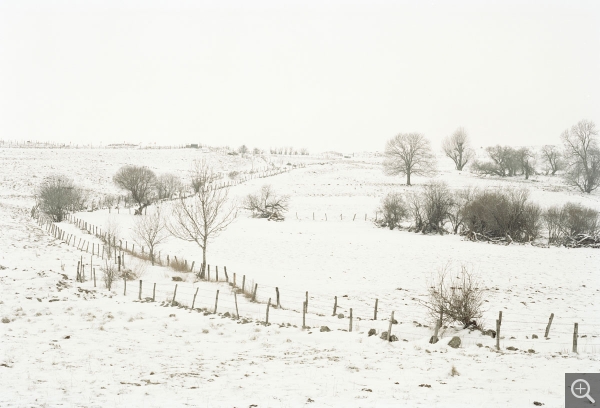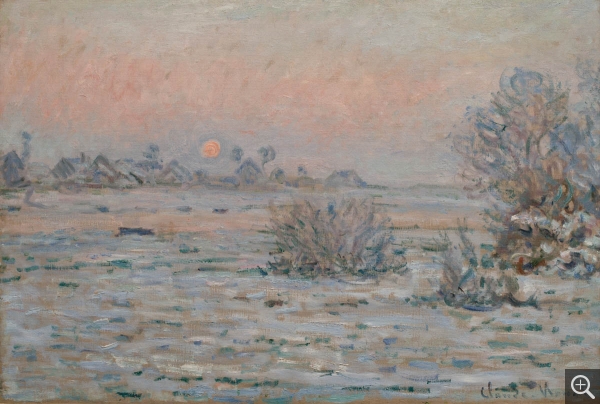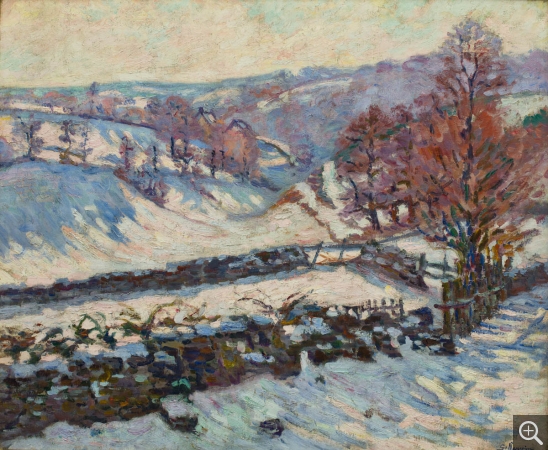Cuisset, Untitled (Aubrac, Lozère)
Untitled (Aubrac, Lozère) is part of the "French Countryside/Fragments" series Thibault Cuisset began in 2009.
Describing his project, the artist writes, "Photographing the French countryside is something that has interested me for some time now: not a picturesque countryside or an exotic countryside, but one that is closer to us, perhaps more ordinary, something that is still very much alive and in which things sometimes move slowly, and other times very quickly. These places we are told little about are nevertheless part of the highly diverse landscape found in France. All these landscapes are the result of a constant shaping process that I strive to render and authenticate as the pure effect of passing time, dealing as accurately as I can with both their equilibrium and their upheavals."
Thibaut Cuisset enjoys visiting and revisiting these places with the changing seasons. In the winter, he stops on a stretch of the Aubrac plateau, motionless beneath the snow, far from any sign of life. Only the "draille", the winding cattle track that the herds used to move between summer and winter pastures, provides a glimpse of human occupation, without knowing whether it belongs to the present or is already in the past. Regardless, time suspended and silence are what the artist captures in this winter landscape, a kind of monochrome white wrapped in a subdued, slightly hazy, light: meadows blanketed in a thin film of snow like the sky.
A contemporary echo of two Impressionist paintings at MuMa (Monet's Winter Sun at Lavacourt and Guillaumin's Snowy Landscape at Crozant), this work demonstrates artists' endless fascination for this meteorological element called snow, and the difference in their aesthetic approaches: a white that is never pure, but rather coloured for the first two, and, just the opposite, a white pure to the point of monochrome for the second.
Describing his project, the artist writes, "Photographing the French countryside is something that has interested me for some time now: not a picturesque countryside or an exotic countryside, but one that is closer to us, perhaps more ordinary, something that is still very much alive and in which things sometimes move slowly, and other times very quickly. These places we are told little about are nevertheless part of the highly diverse landscape found in France. All these landscapes are the result of a constant shaping process that I strive to render and authenticate as the pure effect of passing time, dealing as accurately as I can with both their equilibrium and their upheavals."
Thibaut Cuisset enjoys visiting and revisiting these places with the changing seasons. In the winter, he stops on a stretch of the Aubrac plateau, motionless beneath the snow, far from any sign of life. Only the "draille", the winding cattle track that the herds used to move between summer and winter pastures, provides a glimpse of human occupation, without knowing whether it belongs to the present or is already in the past. Regardless, time suspended and silence are what the artist captures in this winter landscape, a kind of monochrome white wrapped in a subdued, slightly hazy, light: meadows blanketed in a thin film of snow like the sky.
A contemporary echo of two Impressionist paintings at MuMa (Monet's Winter Sun at Lavacourt and Guillaumin's Snowy Landscape at Crozant), this work demonstrates artists' endless fascination for this meteorological element called snow, and the difference in their aesthetic approaches: a white that is never pure, but rather coloured for the first two, and, just the opposite, a white pure to the point of monochrome for the second.
- Claude MONET (1840-1926), Winter Sun,Lavacourt, 1879-1880, oil on canvas, 55 x 81 cm. © MuMa Le Havre / David Fogel
- Thibaut CUISSET (1958-2017), Untitled (Aubrac, Lozère), 2009-2010, photography laminated on aluminum, 92 x 125 cm. © MuMa Le Havre / Thibault Cuisset
- Armand GUILLAUMIN (1841-1927), Snowy Landscape at Crozant, vers 1895, oil on canvas, 60 x 73 cm. © MuMa Le Havre / David Fogel
Learn more








